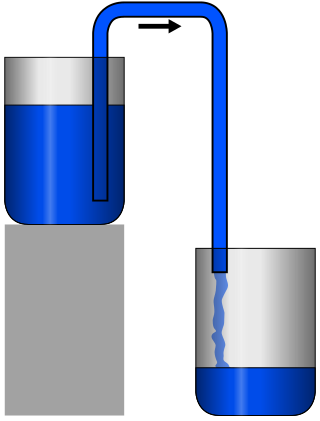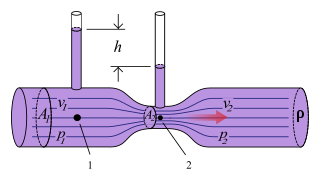
In physics, physical chemistry and engineering, fluid dynamics is a subdiscipline of fluid mechanics that describes the flow of fluids—liquids and gases. It has several subdisciplines, including aerodynamics and hydrodynamics. Fluid dynamics has a wide range of applications, including calculating forces and moments on aircraft, determining the mass flow rate of petroleum through pipelines, predicting weather patterns, understanding nebulae in interstellar space and modelling fission weapon detonation.

A fluid flowing around an object exerts a force on it. Lift is the component of this force that is perpendicular to the oncoming flow direction. It contrasts with the drag force, which is the component of the force parallel to the flow direction. Lift conventionally acts in an upward direction in order to counter the force of gravity, but it can act in any direction at right angles to the flow.

A pump is a device that moves fluids, or sometimes slurries, by mechanical action, typically converted from electrical energy into hydraulic energy.

Bernoulli's principle is a key concept in fluid dynamics that relates pressure, speed and height. Bernoulli's principle states that an increase in the speed of a fluid occurs simultaneously with a decrease in static pressure or the fluid's potential energy. The principle is named after the Swiss mathematician and physicist Daniel Bernoulli, who published it in his book Hydrodynamica in 1738. Although Bernoulli deduced that pressure decreases when the flow speed increases, it was Leonhard Euler in 1752 who derived Bernoulli's equation in its usual form.

The Coandă effect is the tendency of a fluid jet to stay attached to a convex surface. Merriam-Webster describes it as "the tendency of a jet of fluid emerging from an orifice to follow an adjacent flat or curved surface and to entrain fluid from the surroundings so that a region of lower pressure develops."
The shower-curtain effect in physics describes the phenomenon of a shower curtain being blown inward when a shower is running. The problem of identifying the cause of this effect has been featured in Scientific American magazine, with several theories given to explain the phenomenon but no definite conclusion.

A siphon is any of a wide variety of devices that involve the flow of liquids through tubes. In a narrower sense, the word refers particularly to a tube in an inverted "U" shape, which causes a liquid to flow upward, above the surface of a reservoir, with no pump, but powered by the fall of the liquid as it flows down the tube under the pull of gravity, then discharging at a level lower than the surface of the reservoir from which it came.

The Venturi effect is the reduction in fluid pressure that results when a fluid flows through a constricted section of a pipe. The Venturi effect is named after its discoverer, the 18th-century Italian physicist Giovanni Battista Venturi.
A vacuum ejector, or simply ejector is a type of vacuum pump, which produces vacuum by means of the Venturi effect.

Dredging is the excavation of material from a water environment. Possible reasons for dredging include improving existing water features; reshaping land and water features to alter drainage, navigability, and commercial use; constructing dams, dikes, and other controls for streams and shorelines; and recovering valuable mineral deposits or marine life having commercial value. In all but a few situations the excavation is undertaken by a specialist floating plant, known as a dredger.

Hydraulic head or piezometric head is a specific measurement of liquid pressure above a vertical datum.

The history of fluid mechanics is a fundamental strand of the history of physics and engineering. The study of the movement of fluids and the forces that act upon them dates back to pre-history. The field has undergone a continuous evolution, driven by human dependence on water, meteorological conditions and internal biological processes.
Pore water pressure refers to the pressure of groundwater held within a soil or rock, in gaps between particles (pores). Pore water pressures below the phreatic level of the groundwater are measured with piezometers. The vertical pore water pressure distribution in aquifers can generally be assumed to be close to hydrostatic.

Pitometer logs are devices used to measure a ship's speed relative to the water. They are used on both surface ships and submarines. Data from the pitometer log is usually fed directly into the ship's navigation system.
In fluid mechanics, pressure head is the height of a liquid column that corresponds to a particular pressure exerted by the liquid column on the base of its container. It may also be called static pressure head or simply static head.

The draft or draught of a ship's hull is the vertical distance between the waterline and the bottom of the hull (keel). The draught of the vessel is the maximum depth of any part of the vessel, including appendages such as rudders, propellers and drop keels if deployed. Draft determines the minimum depth of water a ship or boat can safely navigate. The related term air draft is the maximum height of any part of the vessel above the water.

The Port Revel Shiphandling Training Centre is a French maritime pilotage school that trains pilots, masters, and officers on large ships like supertankers, container ships, LNG carriers and cruise ships. The facility uses manned models at a 1:25 scale on a man-made lake designed to simulate natural conditions including harbours, canals, and open seas. It was the first such facility in the world. The Centre was created in 1967 near Grenoble, France, by Laboratoire Dauphinois d'Hydraulique.
In fluid dynamics, flow can be decomposed into primary flow plus secondary flow, a relatively weaker flow pattern superimposed on the stronger primary flow pattern. The primary flow is often chosen to be an exact solution to simplified or approximated governing equations, such as potential flow around a wing or geostrophic current or wind on the rotating Earth. In that case, the secondary flow usefully spotlights the effects of complicated real-world terms neglected in those approximated equations. For instance, the consequences of viscosity are spotlighted by secondary flow in the viscous boundary layer, resolving the tea leaf paradox. As another example, if the primary flow is taken to be a balanced flow approximation with net force equated to zero, then the secondary circulation helps spotlight acceleration due to the mild imbalance of forces. A smallness assumption about secondary flow also facilitates linearization.

The squat effect is the hydrodynamic phenomenon by which a vessel moving through shallow water creates an area of reduced pressure that causes the ship to increase its draft and thereby be closer to the seabed than would otherwise be expected. This phenomenon is caused by the water flow which accelerates as it passes between the hull and the seabed in confined waters, the increase in water velocity causing a resultant reduction in pressure. Squat effect from a combination of vertical sinkage and a change of trim may cause the vessel to dip towards the stern or towards the bow. This is understood to be a function of the Block coefficient of the vessel concerned, finer lined vessels Cb <0.7 squatting by the stern and vessels with a Cb >0.7 squatting by the head or bow.
Aerodynamics is a branch of dynamics concerned with the study of the motion of air. It is a sub-field of fluid and gas dynamics, and the term "aerodynamics" is often used when referring to fluid dynamics















